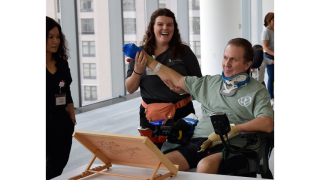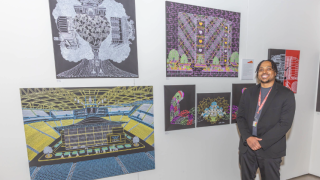Body
In our effort to bridge communication and inclusion in our ever changing world, it is important to remember that everyone we encounter deserves our respect as a basic need, just as we seek their respect for our true nature.
As we approach people [patients/family, clinicians, staff, researchers], it is best not to make any assumptions as many aspects of their character may be invisible, such as disability, LGBTIQ member, culture, and religious practice. As we learn more about a person, let it guide us to greater unity and understanding in a way that brings us all closer. It is okay to make mistakes, and it is okay to say you are sorry. Acknowledging our mistakes as lessons, with sincere remorse and open acceptance of the gentle correction, provides space for a peaceful and respectful community. Once we allow others to exhibit their true selves, we see how diversity benefits and enriches all of our experiences, like a full garden with many blooms.
People with a Disability
Body
Best recommendations for respectful communication for all abilities:
Speak directly to the person.
- Make eye contact with the person. If they use a wheelchair or are of short stature, assume a sitting position if possible to be at eye level.
- Refer to the person directly, rather than in the third person to someone else in the room.
Always obtain the person’s consent before identifying them as a person with a disability.
- Some people, especially those with invisible disabilities, wish not to be identified as such.
Use "person-first" language, to replace handicapped or disabled labels.
- "People who use wheelchairs", "Person living with epilepsy."
- Not everyone prefers person-first language, so ask first when possible or appropriate.
Ask if someone needs assistance rather than assuming a lack of ability.
- If it is not immediately obvious, as them how to best assist them.
Do not pry for details about the person’s disability, or how they became a person with a disability.
- For many people with disabilities, this can be a sensitive and emotional topic.
- If they want to provide that information, they will volunteer it.
Listen to how someone refers to their disability and mirror that language when speaking about them or with them.
- For example, some people may prefer to identify by their diagnosis; others may like to say they use a mobility device rather than disclose their diagnosis.
Do not use words that have negative connotations
- Try to avoid words like victim, defect, invalid, slow.
Do not contrast their disability against something that suggests the person with a disability is abnormal.
- For example, do not call someone without a disability normal, healthy, regular, able-bodied.
When referring to mobility devices, use neutral and clear language to describe what it is.
- For example, use cane, walker, wheelchair, etc.
- Try to avoid using alternate words like scooter, buggy, or just pointing to the device.
- If you do not know what to call the device, ask the person using it.
You may also be interested in reading a blog conversation between Courtney and Lori, called "How to Use Inclusive Language."
ADA Guidelines Guidelines for Writing About People With Disabilities
National Center on Disability and Journalism
United Spinal Association: Disability Etiquette Guide
LGBTIQ
Body
You may encounter a person with or without a disability who also is a member of the LGBTIQ communities.
LGBTIQ: Lesbian, Gay, Bisexual, Transgender, Intersex, Queer
Language is ever changing, and different generations might align with different terminology, which can be confusing.
Use these guides to provide an inclusive atmosphere.
| Use | Avoid | Considerations |
| Gay : males | Homosexual | This is never an adjective for situations or events. |
| Lesbian : females | Lesbianism | |
| Non-binary | Assuming a person's gender identity by appearance | Someone whose gender identity is neither male or female. |
| Sexual orientation | Sexual preference | |
| Transgender | Trans, tranny | Someone whose gender does not align with their birth assignment. |
| Gender identity | Sexual identity | Gender identity (how a person identifies themselves) and gender expression (how a person outwardly expresses their gender) are not interchangeable terms. |
| Marriage | Same-sex marriage | |
| Queer: young LGBTIQ community | Queer: older LGBTIQ community | Younger generations have taken back terms that were offensive in the past, however older generations still find them offensive due to their experience. |
| Pronoun or Personal Gender Pronouns | Pronoun preference |
Pronouns are respectful terms for addressing, and respect is not a preference. It is respectful when meeting someone to introduce yourself with your pronouns. "Hi, my name is Love, and I go by they, them, theirs." "Hi, my name is Jack, and I go by he, him, his." "Hi, my name is Sarah, and I go by she, her, hers." |
| Cisgender | Denoting or relating to a person whose sense of personal identity and gender corresponds with their birth sex. | |
GlAAD: An Ally's Guide to Terminology: Talking About LGBT People & Equality
LGBTIQ Inclusive Language Guide
A Language Guide: Trans and Gender Diverse Inclusion
Cultural Identity
Body
Creating space for cultural respect in the health sciences begins with inclusive behavior and language.
When it comes to the body and spirit, some cultures have unique beliefs towards how people are healed, and have specific rites when it comes to birth, healing and death. It is important as health care providers that we accommodate these needs when able with respect to their cultural heritage and spiritual needs. If we can approach a situation with curiosity and care, we can allow a space for everyone to practice individual customs and spiritual practices.
"Culture is often described as the combination of a body of knowledge, a body of belief and a body of behavior. It involves a number of elements, including personal identification, language, thoughts, communications, actions, customs, beliefs, values, and institutions that are often specific to ethnic, racial, religious, geographic, or social groups." - NIH
National Institute of Health - Cultural Respect for Clear Communication
Human Resources & Services Administration - Culture Language and Health Literacy
ACL- Diversity and Cultural Competency
Body
Contributing Authors:
DAndrea, Dominic | Research Lab Technician | they, them, theirs
Griffin, Courtney | Digital Content Specialist | she, her, hers
Snyder, Lori | Medical Librarian, Zen Buddhist Priest | she, her, hers
Body
This content is for informational purposes only and may not be comprehensive. Information contained does not imply an endorsement from Shirley Ryan AbilityLab, and does not replace the advice of a qualified healthcare professional. See here for further details.



